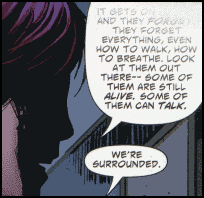There are two books I picked up recently that demonstrate how not to tell a story with pictures: Teen Titans #27 and the manga of The Nightmare Before Christmas.
First, Teen Titans #27, first half of a two parter by fill-in team of Gail Simone and Rob Liefeld. I’d planned on writing a more thorough review, but Comics Should Be Good beat me to it. And yeah, reviewing Liefeld’s art feels like a cheap shot, but sometimes ya just gotta go for it. Simone’s story isn’t bad, but it’s hard to follow. In particular, there are too many places where the art isn’t about story or action, it’s about showing the heroes or villains in dramatic poses. And yeah, you want the occasional dramatic pose, because you want to show off the costumes. That’s part of the genre. But you need to convey what’s actually happening. As dramatic as the last two pages were, I couldn’t figure out just what Kestrel was doing without looking at the “Next issue” blurb!
And then there are the places Liefeld left out dramatic poses that should have been there. The issue introduces a quartet of teen villains, but only one of them gets a full-body dramatic view, two get only action shots, and one—well, let me put it this way. I had to flip back to the beginning to be sure that there really were four of them and not just three. He’s in two panels with only his head and shoulders visible in the entire book. He’s not named, there’s no sign of powers or special skills, and he’s wearing a shirt and tie. I have to wonder whether Liefeld just didn’t get around to designing a costume since the character gets eliminated halfway through the book.
Anyway, onto The Nightmare Before Christmas. Continue reading →
